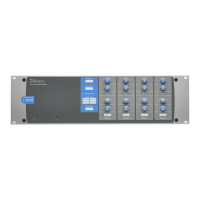Z4-8MK4 Installation and User Guide v1.2 17
SETTING UP & OPERATION
Music Inputs
Gain & level
To avoid dramatic changes in volume when switching between
sources, the Z8MK4/Z4MK4’s music inputs are provided with
preset gain trim controls ([3] on page 9). These vary
the input sensitivity from -11 dBu to +12.5 dBu (approx.
218 mV to 3.2 V). When setting the system up, play audio
from all the sources in use and listen to them one at a time
in a convenient zone (preferably that in which the mixer is
located) at a reasonable volume. Taking a source of “average”
volume as the reference, the gain controls of the others
should be adjusted so that there is no appreciable difference
in volume between any of the sources. (With a typical music
source, setting the gain on its channel to mid-way is a good
starting point.) Note that consideration may need to be given
to the type of programme in use, particularly if one or more
sources are TV sound.
In normal operation, the music level in each zone is set with
the Music Level control on the front panel ([2] on page
8). This control will not be operative if the corresponding
rear panel MUSIC CONTROL push-button is set to
REMOTE. When setting the audio system up, set the gain
controls (if any) on the power ampliers for each zone to
minimum, then turn the Music Level control on the mixer to
maximum. Then increase the zone volume by turning up the
power amplier gain until it is as loud as will be required in
normal use. This method ensures that excessive volumes will
not be possible with the mixer’s operational controls.
Note that the setting of the music level has no effect on
microphone or paging volume.
Local/remote control
If a zone has an RL-1 or RSL-6 Series remote control plate
or an LM-2 mic/line input module connected, the rear panel
MUSIC CONTROL push-button must be set to REMOTE
(button in) for the remote controls to be operative and for
the corresponding front panel controls to be disabled. Zones
without such plates should be set to LOCAL (button out).
The setting of the internal PCB jumper J1 on each zone sub-
board is also relevant. The default setting is SW. This means
that zone music source selection will be determined by the
rear panel switch setting; the front panel control in LOCAL
and via a remote plate or other external control in REMOTE.
If the jumper is set to FR, the source selection will always be
made with the front panel control whatever is connected at
the rear panel or the setting of the MUSIC CONTROL
switch. If external control of music level only (i.e., not source
selection) is required, J1 should be set to FR and the MUSIC
CONTROL switch to REMOTE.
Microphone Inputs
Phantom Power
Each primary microphone input (MICROPHONE 1 &
MICROPHONE 2) has 12 V phantom power available.
This will be adequate to power a wide range of condenser
microphones. (Some “studio quality” mics may require a
higher phantom voltage and thus necessitate an external
PSU.) To enable phantom power at the mic inputs, the
relevant section(s) of the internal motherboard DIP switch
SW3 should be moved to their ON positions. See page 26
for switch locations.
Phantom power should NOT be enabled if dynamic
microphones are to be used.
Gain & level
Each primary microphone input (MICROPHONE 1 &
MICROPHONE 2) is provided with a rear panel preset gain
control ([5] on page 9). A wide range of gain is available
and there should be no problem in obtaining a satisfactory
level from any normal microphone.
The mic GAIN control should be adjusted by speaking
normally into a microphone of the correct type. Turn the
front panel Mic Level control up to maximum and listen in
a convenient zone; the rear panel GAIN control should be
carefully advanced until the mic volume is as loud as it is ever
likely to be needed, and then reduced slightly. There should be
no audible distortion. The use to which the microphone is to
be put should be borne in mind – karaoke is more likely to
overload the mic preamplier than spoken announcements, if
the gain is not set correctly.
In normal operation, the mic level in each zone is set with the
Microphone 1 and 2 level controls on the front panel ([3] &
[4] on page 8).
EQ
Each mic input has associated HF and LF EQ controls ([6]
on page 9) These provide 10 dB of cut or boost at 5 kHz
and 100 Hz respectively and should be adjusted by listening
to achieve a clear mic sound. Again, the application should be
borne in mind when making adjustments.
High-pass lter
Each mic input has a xed 100 Hz high-pass lter to remove
the lowest frequencies. This helps to reduce the effects of
breath blasts and microphone handling noise. The lter is
always in circuit.

